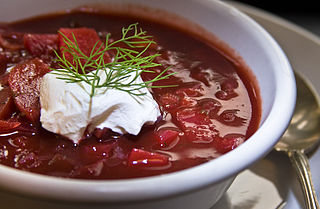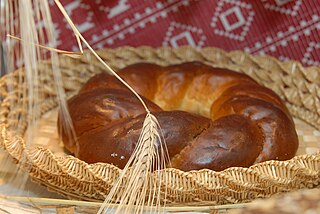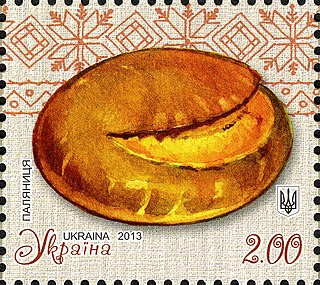
The East Slavic languages constitute one of the three regional subgroups of Slavic languages. These languages are currently spoken natively throughout Eastern Europe and extend eastwards to Siberia and the Russian Far East; while being also spoken as a lingua franca in many regions of Caucasus and Central Asia. Speakers of East Slavic languages far out-number the West Slavic and South Slavic language families.

Borscht is a sour soup common in Eastern Europe and Northern Asia. In English, the word "borscht" is most often associated with the soup's variant of Ukrainian origin, made with red beetroots as one of the main ingredients, which give the dish its distinctive red color. The same name, however, is also used for a wide selection of sour-tasting soups without beetroots, such as sorrel-based green borscht, rye-based white borscht, and cabbage borscht.

Ruthenian and Ruthene are exonyms of Latin origin, formerly used in Eastern and Central Europe as common ethnonyms for East Slavs, particularly during the late medieval and early modern periods. The Latin term Rutheni was used in medieval sources to describe all Eastern Slavs of the Grand Duchy of Lithuania, as an exonym for people of the former Kievan Rus', thus including ancestors of the modern Ukrainians, Rusyns, and Belarusians. The use of Ruthenian and related exonyms continued through the early modern period, developing several distinctive meanings, both in terms of their regional scopes and additional religious connotations.

Pączki are filled doughnuts found in Polish cuisine.

Polish cuisine is a style of cooking and food preparation originating in or widely popular in Poland. Polish cuisine has evolved over the centuries to become very eclectic due to Poland's history and it shares many similarities with other regional cuisines. Polish-styled cooking in other cultures is often referred to as à la polonaise.

A Kyiv cake is a brand of dessert cake, made in Kyiv, Ukraine since December 6, 1956 by the Karl Marx Confectionery Factory. It soon became popular all over the Soviet Union.

Kolach or kalach is a traditional Eastern European bread, commonly served during various ritual meals. The name originates from the Old Slavonic word kolo (коло) meaning "circle" or "wheel". Korovai is sometimes categorised as a type of kolach.

A torte (from German Torte is a rich, usually multilayered, cake that is filled with whipped cream, buttercreams, mousses, jams, or fruits.
Jacek Podsiadło is a Polish poet, writer, translator and essayist. Sometimes he uses a pen name Jac Po. He is one of the poets of the famous Polish bruLion generation. He had many professions, he now works in the Opole radio station.

The Przebraże Defence – defensive fights in the village of Przebraże belonging to the Trościaniec cluster, in Lutsk poviat, voivodeship in Volhynia between July 1943 and January 1944. In Przebraże, Polish civilians from Volhynia organized defense against the UPA. The village was never conquered by UPAs.

Władysław Witwicki was a Polish psychologist, philosopher, translator, historian and artist. He is seen as one of the fathers of psychology in Poland.

Dobra is a village in the administrative district of Gmina Sieniawa, within Przeworsk County, Subcarpathian Voivodeship, in south-eastern Poland.
Dobra is a village in the administrative district of Gmina Staszów, within Staszów County, Świętokrzyskie Voivodeship, in south-central Poland. It lies approximately 5 kilometres (3 mi) north-east of Staszów and 53 km (33 mi) south-east of the regional capital Kielce.
Dobra is a village in the administrative district of Gmina Sanok, within Sanok County, Subcarpathian Voivodeship, in south-eastern Poland. It lies approximately 12 kilometres (7 mi) north-east of Sanok and 50 km (31 mi) south-east of the regional capital Rzeszów.

A rum baba or baba au rhum is a small yeast cake saturated in syrup made with hard liquor, usually rum, and sometimes filled with whipped cream or pastry cream. It is most typically made in individual servings but sometimes can be made in larger forms similar to those used for Bundt cakes.
The holiday of Easter is associated with various Easter customs and foodways. Preparing, coloring, and decorating Easter eggs is one such popular tradition. Lamb is eaten in many countries, mirroring the Jewish Passover meal.

A babka is a sweet braided bread or cake which originated in the Jewish communities of Poland, Russia and Ukraine. It is popular in Israel and in the Jewish diaspora. It is prepared with a yeast-leavened dough that is rolled out and spread with a filling such as chocolate, cinnamon, fruit, or cheese, then rolled up and braided before baking.

Palianytsia is a type of Ukrainian hearth-baked bread, made mostly of wheat flour in a home oven. The yeast hearth bread has a semi-circular cut across the top third of the loaf.















